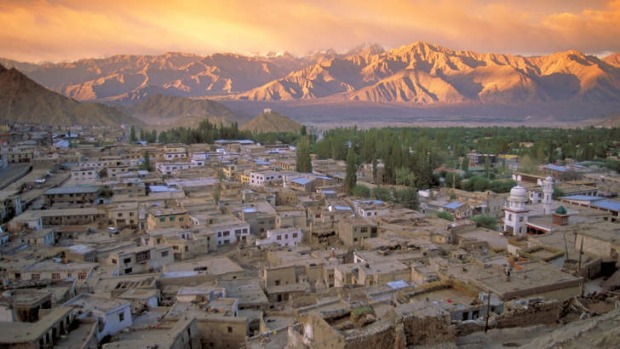
Just one brief syllable designed for the short-of-breath, Leh is the capital of Ladakh, in India's northern trans-Himalayan region.
Its position, at 3524 metres above sea level, is breathtaking - literally.
The city sits in the valley of the Indus River, between the peaks of the Himalayas and the Karakorams, the two mightiest mountain ranges on the planet.
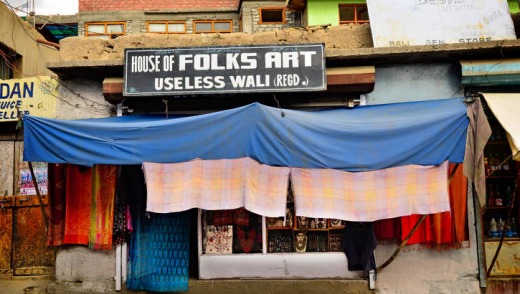
The region is essentially a high-altitude desert, since the mountain peaks bar rain clouds.
The brilliant green floor of the valley is a stark contrast with the stony, dusty slopes of the perennially snow-capped peaks that surround it.
These credentials make the city a popular base camp for whitewater rafting, extreme biking adventures on the world's highest roads and some exceptional treks.
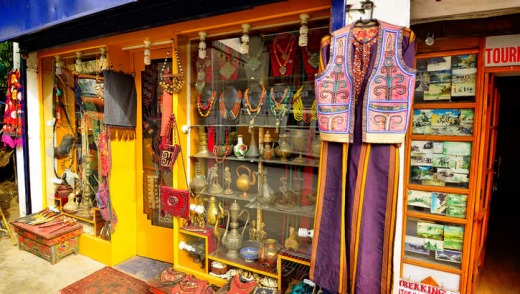
Included on the list is the Chadar Trek, a mid-winter walk along the ice-covered Zanskar River, following the journey of villagers who load butter onto pack animals and set off through the sheer-sided gorge on a 10-day walk to Leh.
In ethnicity and culture, Ladakh takes its cues from Tibet, which lies just to the east, and Leh is one of the best places to experience the magic and mysticism of an intact Tibetan Buddhist culture.
6.30AM
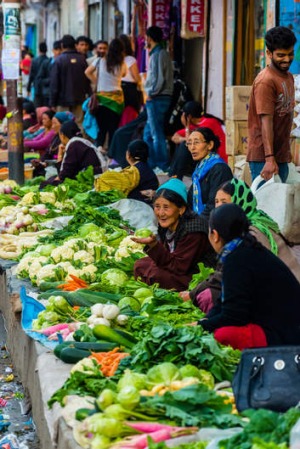
Also known as the mini Potala, Thikse is possibly the most spectacular of the Buddhist monasteries around Leh, a photogenic complex sited on the crest of a hill a few kilometres from the city. Visitors are welcome to attend the early morning prayer sessions and even to take photos when monks chant the Buddhist canon, to the sound of clashing cymbals and banging drums.
The monks are served butter tea and tsampa, roasted barley flour, by mischievous boy monks who are otherwise chatting and looking for excuses to go outside and fool around. Breakfast at the cafe beside the footpath leading back down the hill.
8.30AM
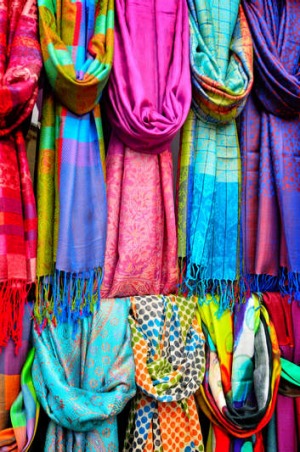
Continue to Hemis Gompa, which lies about 20 kilometres east of Thikse on the opposite side of the Indus River. Tucked away in the twists of a serpentine valley that preserved it from looting armies, Hemis is the largest and richest of all the Buddhist monasteries in Ladakh.
The magnificent main prayer hall has a gallery running around its upper storey and thangkas draped from the walls.
The museum houses a notable collection of Buddhist artworks, many of them ancient.
The temple is at its most spectacular for the Hemis Festival held in June or July, when villagers and goat-herding nomads from far-flung regions congregate to watch the lamas of Hemis perform masked dances in one of the dazzling highlights of the Buddhist calendar.
12.30PM
Set on a big terrace above bustling Old Fort Road, Chopsticks has a menu strong on Asian favourites, Thai green curry to Tibetan momos. The noodle soups are excellent and alcoholic beverages are available from the bar next door. The banquettes in the big three-sided booths are a great lounging spot on a warm afternoon.
1.30PM
Time for retail therapy. Leh is a stronghold of Tibetan culture and the city's curio shops are full of Tibetan arts and artefacts. Prayer beads made from yak bone, high-topped lama hats, chunky jewellery, Buddha figurines and thangka paintings - if you want to jazz up home or life with ethnic bling, there is nowhere better.
The pashmina is another specialty of Ladakh, made from the finest hair from goats herded by nomadic shepherds close to the Tibetan border. The hair is woven in Kashmir, which has a historic monopoly in the trade, but the shops of Leh are a great place to buy, and prices are keen.
Try the Kashmiri shops in Old Fort Road, or take your chances in the bazaar. Thanks to the Kashmiri traders who make Leh their summer home, the city is well supplied with carpet shops.
From coarse traditional wool rugs woven by nomadic herders to shimmering carpets made from blended silk and wool, the choice is dazzling, but be prepared to bargain hard over many hours before an expensive purchase.
The outdoor gear shops in Main Bazaar Road can sell you most of what you need to tackle some of the wildest mountain terrain on the planet. Beware of imitations, but much of the gear they sell is superseded stock from high-quality brands, and there are plenty of bargains in pants, jackets and backpacks especially, although the choice of footwear is limited.
3.30PM
Snack time, and while there are a couple of German bakeries in Leh, the superior version is the Pumpernickel, near the corner of Old Fort Road and Main Bazaar Road.
Fruity pies, apple strudel, apricot crumble almond cakes, fresh apricot nectar and Gulbadan apple juice are some of the staples. The tables on the verandah are prime, but be prepared to share.
4.30PM
Built in the 17th century, Leh Palace is a seven-storey, mud-walled hilltop complex that overlooks the old town and invites comparisons with the Potala in Lhasa. The palace fell into disrepair after it was shorn of its royal function following the exile of the Namgyal dynasty in the 1800s, but it is now slowly being restored by the Archaeological Survey of India.
Anything that could be removed from the interior has long since disappeared, but the carved and painted wooden pillars inside are a testament to Ladakhi craftsmanship. The rooftop offers lovely views over Leh and its surrounds to the snow-capped peaks of the Zanskar Range, at their best towards sunset.
7.30PM
Bon Appetit is Leh's supreme dining experience, a modernist restaurant with tables set across a flagstone patio as well as inside. Although the mutton burgers, roast vegetable sandwiches, pasta dishes and salads would not cause a stampede in too many other places, they fulfil the food fantasies of travellers who have spent days sucking thin air out in the wilderness.
The cocktails are a cut above, and bring a torch if you go for dinner.
TRIP NOTES
GETTING THERE
Jet Airways and Indian Airlines both operate flights between Leh and New Delhi. Book well in advance, seats are scarce during the brief tourist season.
GETTING AROUND
Get used to panting. Leh sits at 3500 metres, and this is a low point in the Ladakhi scheme of things. Even walking up a slight incline will have you puffing for breath. Take it easy, and drink plenty of fluids. Taxis are readily available for longer journeys.
MORE INFORMATION
incredibleindia.org